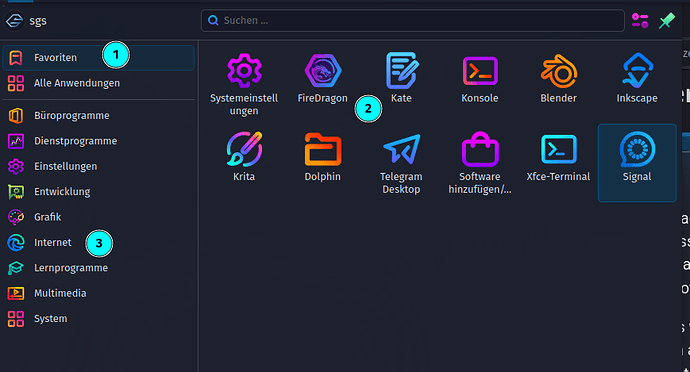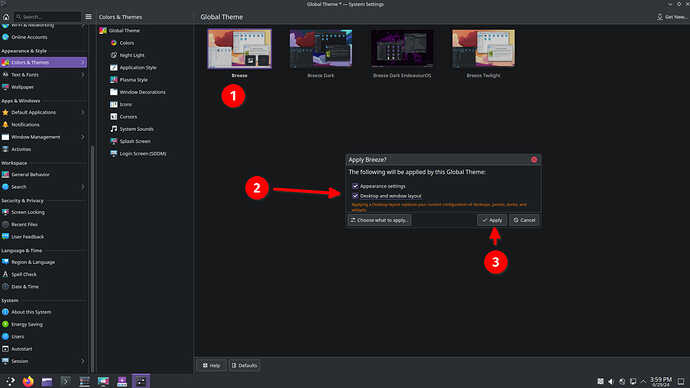I just installed Garuda Dragonized onto my computer for the first time, and after going through the whole process of setup and installing the apps I want, none of them are showing up on my applications menu–not even the default apps such as FireDragon (I’m posting this from another device since I can’t use any browsers).
I’m able to attach various widgets to the bottom bar, oddly enough. One such widget being the Konsole, so I’m able to use terminal commands at least. I tried to install one of the apps I chose from the menu, but the terminal told me that that app was already up to date.
I tried looking online for answers, but all I found were posts from three years ago talking about how their apps disappeared after installing a “DashToPanel” package.
System:
Kernel: 6.9.6-zen1-1-zen arch: x86_64 bits: 64
compiler: gcc v: 14.1.1 clocksource: tsc
avail: hpet,acpi_pm
parameters: BOOT_IMAGE=/@/boot/vmlinuz-linux-zen
root=UUID=609dbc6d-ecf6-40f4-ae1c-b436d566f2e5 rw
rootflags=subvol=@ quiet
resume=UUID=29ca609b-c056-4a13-934d-90dfd30b1a0a
loglevel=3 ibt=off
Desktop: KDE Plasma v: 6.1.0 tk: Qt v: N/A
info: frameworks v: 6.3.0 wm: kwin_wayland vt: 1 dm: SDDM
Distro: Garuda base: Arch Linux
Machine:
Type: Desktop System: Dell product: OptiPlex 980 v: N/A
serial: <superuser required> Chassis: type: 15
serial: <superuser required>
Mobo: Dell model: 0C522T v: A01
serial: <superuser required> uuid: <superuser required>
BIOS: Dell v: A18 date: 02/27/2018
CPU:
Info: model: Intel Core i5 660 bits: 64 type: MT MCP
arch: Westmere gen: core 1 level: v2 built: 2010-11
process: Intel 32nm family: 6 model-id: 0x25 (37)
stepping: 5 microcode: 0x7
Topology: cpus: 1x cores: 2 tpc: 2 threads: 4
smt: enabled cache: L1: 128 KiB
desc: d-2x32 KiB; i-2x32 KiB L2: 512 KiB
desc: 2x256 KiB L3: 4 MiB desc: 1x4 MiB
Speed (MHz): avg: 1262 high: 1457 min/max: 1197/3326
boost: enabled scaling: driver: acpi-cpufreq
governor: schedutil cores: 1: 1197 2: 1197 3: 1197
4: 1457 bogomips: 26601
Flags: ht lm nx pae sse sse2 sse3 sse4_1 sse4_2 ssse3
vmx
Vulnerabilities: <filter>
Graphics:
Device-1: Intel Core Processor Integrated Graphics
vendor: Dell driver: i915 v: kernel arch: Gen-5.75
process: Intel 45nm built: 2010 ports: active: VGA-1
empty: DP-1,HDMI-A-1 bus-ID: 00:02.0 chip-ID: 8086:0042
class-ID: 0300
Display: wayland server: X.org v: 1.21.1.13
with: Xwayland v: 24.1.0 compositor: kwin_wayland driver:
X: loaded: modesetting alternate: fbdev,intel,vesa
dri: crocus gpu: i915 display-ID: 0
Monitor-1: VGA-1 res: 640x480 size: N/A modes: N/A
API: EGL v: 1.5 hw: drv: intel crocus platforms:
device: 0 drv: crocus device: 1 drv: swrast surfaceless:
drv: crocus wayland: drv: crocus x11: drv: crocus
inactive: gbm
API: OpenGL v: 4.5 compat-v: 2.1 vendor: intel mesa
v: 24.1.2-arch1.1 glx-v: 1.4 direct-render: yes
renderer: Mesa Intel HD Graphics (ILK)
device-ID: 8086:0042 memory: 1.46 GiB unified: yes
display-ID: :1.0
API: Vulkan v: 1.3.279 layers: 3 device: 0 type: cpu
name: llvmpipe (LLVM 17.0.6 128 bits)
driver: mesa llvmpipe v: 24.1.2-arch1.1 (LLVM 17.0.6)
device-ID: 10005:0000 surfaces: xcb,xlib,wayland
Audio:
Device-1: Intel 5 Series/3400 Series High Definition
Audio vendor: Dell OptiPlex 980 driver: snd_hda_intel
v: kernel bus-ID: 00:1b.0 chip-ID: 8086:3b56
class-ID: 0403
API: ALSA v: k6.9.6-zen1-1-zen status: kernel-api
with: aoss type: oss-emulator tools: N/A
Server-1: PipeWire v: 1.0.7 status: active with:
1: pipewire-pulse status: active 2: wireplumber
status: active 3: pipewire-alsa type: plugin 4: pw-jack
type: plugin tools: pactl,pw-cat,pw-cli,wpctl
Network:
Device-1: Intel 82578DM Gigabit Network
vendor: Dell OptiPlex 980 driver: e1000e v: kernel
port: ecc0 bus-ID: 00:19.0 chip-ID: 8086:10ef
class-ID: 0200
IF: eno1 state: up speed: 1000 Mbps duplex: full
mac: <filter>
Info: services: NetworkManager, smbd, systemd-timesyncd
RAID:
Hardware-1: Intel SATA Controller [RAID mode]
driver: ahci v: 3.0 port: fec0 bus-ID: 00:1f.2
chip-ID: 8086:2822 rev: N/A class-ID: 0104
Drives:
Local Storage: total: 74.51 GiB used: 12.63 GiB (17.0%)
SMART Message: Unable to run smartctl. Root privileges
required.
ID-1: /dev/sda maj-min: 8:0 vendor: Seagate
model: ST380819AS size: 74.51 GiB block-size:
physical: 512 B logical: 512 B speed: 3.0 Gb/s
tech: N/A serial: <filter> fw-rev: 8.04 scheme: MBR
Partition:
ID-1: / raw-size: 65.7 GiB size: 65.7 GiB (100.00%)
used: 12.63 GiB (19.2%) fs: btrfs dev: /dev/sda1
maj-min: 8:1
ID-2: /home raw-size: 65.7 GiB size: 65.7 GiB (100.00%)
used: 12.63 GiB (19.2%) fs: btrfs dev: /dev/sda1
maj-min: 8:1
ID-3: /var/log raw-size: 65.7 GiB
size: 65.7 GiB (100.00%) used: 12.63 GiB (19.2%)
fs: btrfs dev: /dev/sda1 maj-min: 8:1
ID-4: /var/tmp raw-size: 65.7 GiB
size: 65.7 GiB (100.00%) used: 12.63 GiB (19.2%)
fs: btrfs dev: /dev/sda1 maj-min: 8:1
Swap:
Kernel: swappiness: 133 (default 60)
cache-pressure: 100 (default) zswap: no
ID-1: swap-1 type: zram size: 7.56 GiB
used: 0 KiB (0.0%) priority: 100 comp: zstd
avail: lzo,lzo-rle,lz4,lz4hc,842 max-streams: 4
dev: /dev/zram0
ID-2: swap-2 type: partition size: 8.8 GiB
used: 0 KiB (0.0%) priority: -2 dev: /dev/sda2
maj-min: 8:2
Sensors:
System Temperatures: cpu: 38.0 C mobo: N/A
Fan Speeds (rpm): N/A
Info:
Memory: total: 8 GiB available: 7.56 GiB
used: 1.23 GiB (16.2%)
Processes: 216 Power: uptime: 4m
states: freeze,standby,mem,disk suspend: deep
avail: s2idle,shallow wakeups: 0 hibernate: platform
avail: shutdown, reboot, suspend, test_resume
image: 3.01 GiB services: org_kde_powerdevil,
power-profiles-daemon, upowerd Init: systemd v: 256
default: graphical tool: systemctl
Packages: pm: pacman pkgs: 1378 libs: 409
tools: gnome-software, octopi, pamac, paru Compilers:
gcc: 14.1.1 Shell: garuda-inxi default: fish v: 3.7.1
running-in: konsole inxi: 3.3.35
Garuda (2.6.26-1):
System install date: 2024-06-26
Last full system update: 2024-06-26 ↻
Is partially upgraded: No
Relevant software: snapper NetworkManager dracut
Windows dual boot: <superuser required>
Failed units:



